QuickLinks:
2450, 2451, 2452, 2453, 2454, 2455, 2456, 2457, 2458, 2459, 2460, 2461, 2462, 2463, 2464, 2465, 2466,
2467, 2468, 2469, 2470, 2471, 2472, 2473, 2474, 2475, 2476, 2477, 2478, 2479, 2480, 2481, 2482, 2483,
2484, 2485, 2486, 2487, 2488, 2489, 2490, 2491, 2492, 2493, 2494, 2495, 2496, 2497, 2498, 2499
Last updated Aug 23, 2023 (Added Caldwell ID, etc, for NGC 2477)
Last updated Nov 14, 2018
Entered Dreyer NGC entries, checked Steinicke historical/physical databases
(Need to check other historical references, and Steinicke NGC 2478)
Checked Corwin positions
WORKING 2463: Basic pix, tags
WORKING: proper identifications of eight objects in Lynx
WORKING: Corwin/Gottlieb historical information, LEDA/NED data, better pix
NEED TO CHECK FOR ANY NGC notes (errata and IC notes already entered)
NGC 2450 (= PGC 21807)
Discovered (Feb 26, 1878) by Édouard Stephan
A magnitude 14.7 spiral galaxy (type Sbc?) in Gemini (RA 07 47 32.3, Dec +27 01 09)
Historical Identification: Per Dreyer, NGC 2450 (Stephan list IX (12), 1860 RA 07 38 55, NPD 62 38.3) is "extremely faint, very small, small star involved".
Physical Information: Based on a recessional velocity of 4805 km/sec, NGC 2450 is about 225 million light years away. Given that and its apparent size of 0.8 by 0.15 arcmins, it is about 50 thousand light years across.

Above, a 2.4 arcmin wide closeup of NGC 2450
Below, a 12 arcmin wide region centered on the galaxy; also shown are NGC 2449 and IC 476

NGC 2451 (= OCL 716)
Probably observed (before 1654) by Giovanni Hodierna
Discovered (Feb 1, 1835) by John Herschel
A magnitude 2.8 open cluster (type II2p) in Puppis (RA 07 45 14.0, Dec -37 58 00)
Historical Identification: Per Dreyer, NGC 2451 (= GC 1573 = JH 3099, 1860 RA 07 40 19, NPD 127 38.3) is "a cluster, very very large, very little compressed, 1 star of magnitude 4.5". (See a discussion of Hodierna for an explanation of why he received no credit for any of his NGC discoveries; in this case, there is the additional problem that he did not include the object in his short catalog of discoveries. Instead, he drew a picture (V.3) of a region in Puppis which is probably of this cluster, but lacking catalog information is not as certainly identified.)
Physical Information: NGC 2451 is actually two clusters, which just happen to be in exactly the same direction, nearly centered on the brightest star in the group, the 3.6 magnitude yellow giant c Puppis. The nearer cluster, NGC 2451A, is about 600 light years away, while the more distant NGC 2451B is about 1200 light years away. Each seems to contain a hundred or more stars (70 Main Sequence stars have been confirmed in NGC 2451A, just counting down to magnitude 15), and to have formed at about the same time, 50 to 60 million years ago; so the two may have formed in the same star-forming region, at about the same time, and gradually drifted apart since their formation. The overall apparent size of the "cluster" is about 45 arcmin, which implies that the nearer cluster (which should look larger, given its smaller distance) is about 8 light years across, and although information about the more distant one is harder to come by, it is probably also less than 10 light years across.

Above, a 1 degree wide view of NGC 2451
Below, a 2.5 degree wide region showing NGC 2451 and the much more distant NGC 2477
Also shown are extensive clouds of gas and dust which wreath the region
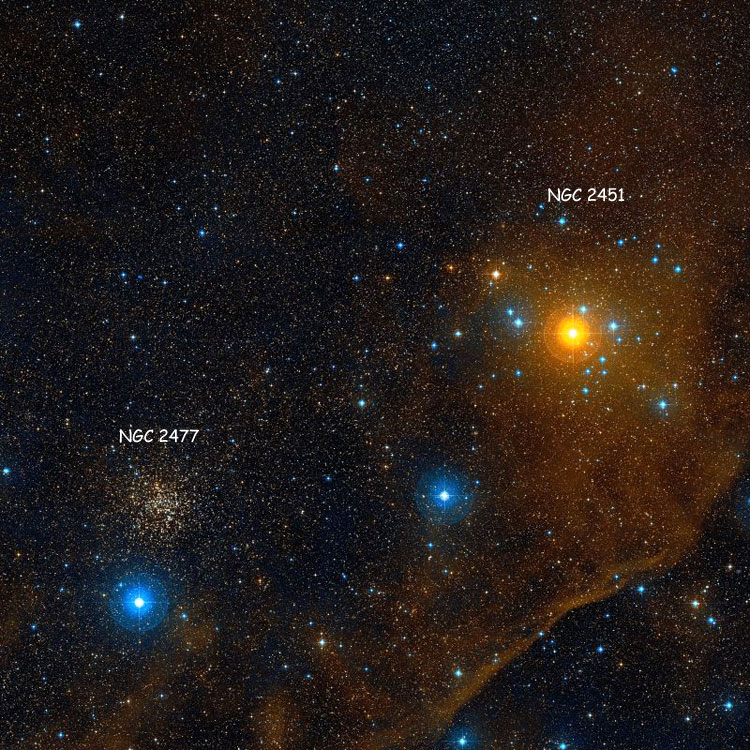
NGC 2452 (= P-K 243-01.1 = "PGC 3517757")
Discovered (Feb 1, 1837) by John Herschel
Also observed (date?) by Sherburne Burnham
A magnitude 12.0 planetary nebula in Puppis (RA 07 47 26.3, Dec -27 20 07)
Historical Identification: Per Dreyer, NGC 2452 (= GC 1574 = JH 3100, 1860 RA 07 41 47, NPD 117 00.1) is "a planetary nebula, faint, small, a little extended, among 60 stars". The first IC incorrectly states (per Burnham) "Not planetary, but bi-nuclear".
PGC Designation Note: For purposes of completeness, LEDA assigns a PGC designation to this object despite its not being a galaxy; however, a search of the database for the PGC designation returns no result, so it is shown in quotes.
Physical Information:

Above, a 12 arcmin wide DSS image centered on NGC 2452; NGC 2453 lies just out-of-field to the north
Below, a 0.8 arcmin wide PanSTARRS image of the planetary nebula
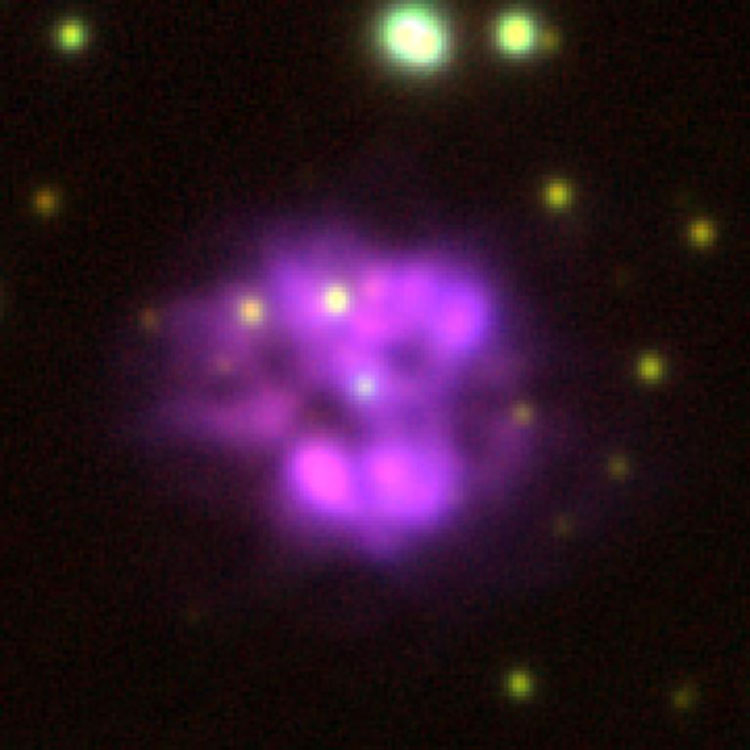
Below, a 0.54 by 0.48 arcmin wide HST image of the nebula (Hubble Legacy Archive, Fabian)
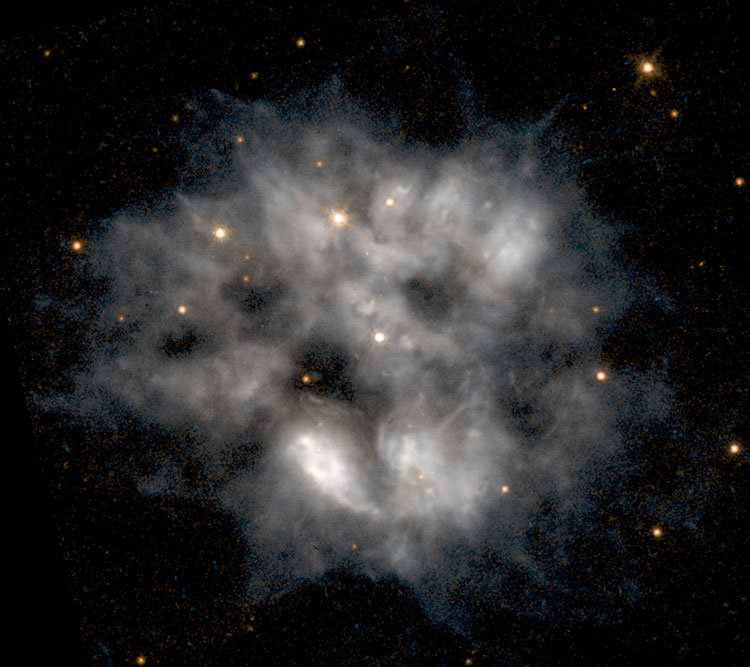
NGC 2453 (= OCL 670)
Discovered (Feb 5, 1837) by John Herschel
A magnitude 8.3 open cluster (type I2p) in Puppis (RA 07 47 33.0, Dec -27 11 42)
Historical Identification: Per Dreyer, NGC 2453 (= GC 1575 = JH 3101, 1860 RA 07 41 57, NPD 116 54.4) is "a cluster, small, pretty rich, pretty compressed".
Physical Information: About two dozen stars thickly clustered within a 4 arcmin wide region. Planetary nebula NGC 2452 is only 8 arcmin to the south-southwest, so the wider-field image is set up to show its position as well.
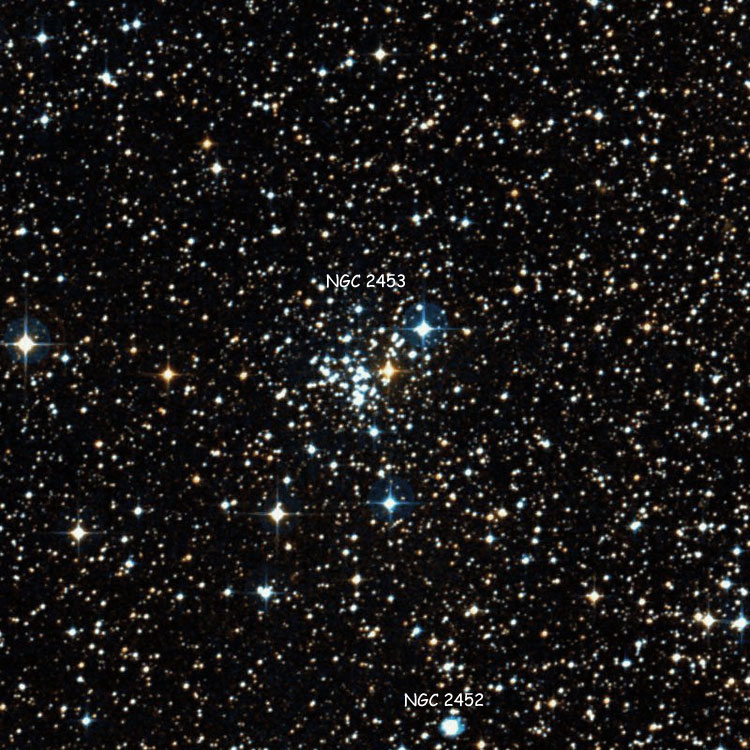
Above, an 18 arcmin wide DSS image centered on NGC 2453, also showing NGC 2452
Below, a 5 arcmin wide DSS image of the open cluster
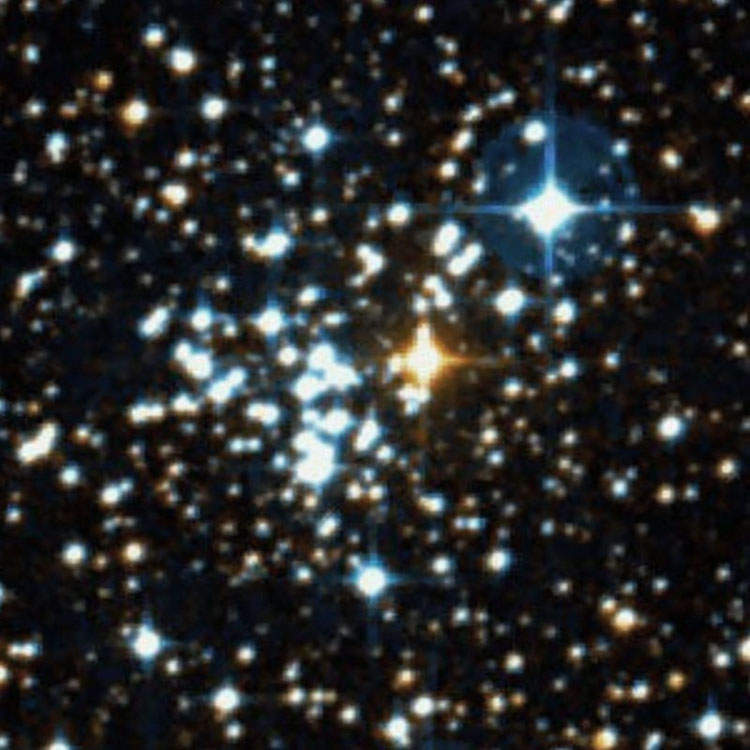
NGC 2454 (= PGC 21963)
Discovered (Jan 19, 1874) by Édouard Stephan (6-10)
A magnitude 13.8 spiral galaxy (type S?) in Gemini (RA 07 50 35.0, Dec +16 22 07)
Historical Identification: Per Dreyer, NGC 2454 (= GC 5395 = Stephan list VI (#10), 1860 RA 07 42 35, NPD 73 16.9) is "very faint, extremely small, round, brighter middle".
Physical Information: Apparent size 0.8 by 0.3 arcmin

Above, a 2.4 arcmin wide closeup of NGC 2454
Below, a 12 arcmin wide region centered on the galaxy

NGC 2455 (= OCL 636)
Discovered (Feb 15, 1836) by John Herschel
A magnitude 10.2 open cluster (type III2p) in Puppis (RA 07 49 01.0, Dec -21 20 00)
Historical Identification: Per Dreyer, NGC 2455 (= GC 1576 = JH 3102, 1860 RA 07 42 52, NPD 110 57.1) is "a cluster, considerably large, pretty rich, a little compressed, stars of 12th magnitude". The position precesses to RA 07 48 57.5, Dec -21 17 57, which is close enough to wherever the true center lies that the identification is certain.
Physical Information: NGC 2455 consists of several dozen stars of about 12th magnitude scattered across a 10 to 15 arcmin wide region, but the surrounding star field is so dense that it's hard to tell where the cluster ends and the starry background begins.
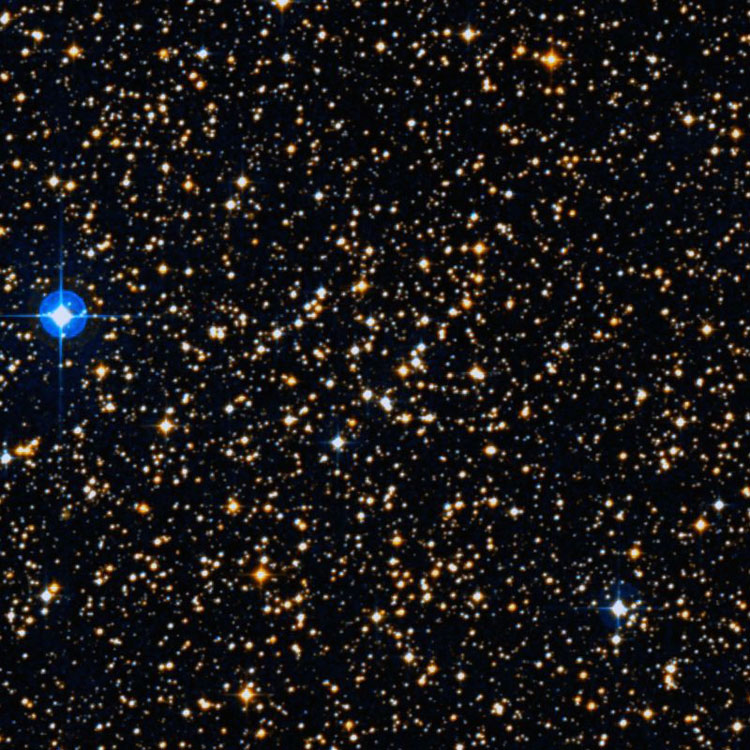
Above, an 18 arcmin wide region centered on NGC 2455
NGC 2456 (= PGC 22129)
Discovered (Feb 10, 1831) by John Herschel
A magnitude 13.1 elliptical galaxy (type E3?) in Lynx (RA 07 54 10.7, Dec +55 29 43)
Historical Identification: Per Dreyer, NGC 2456 (= GC 1577 = JH 467, 1860 RA 07 42 57, NPD 34 09.4) is "very faint, round, very gradually brighter middle".
Physical Information: Apparent size 1.1 by 0.8 arcmin
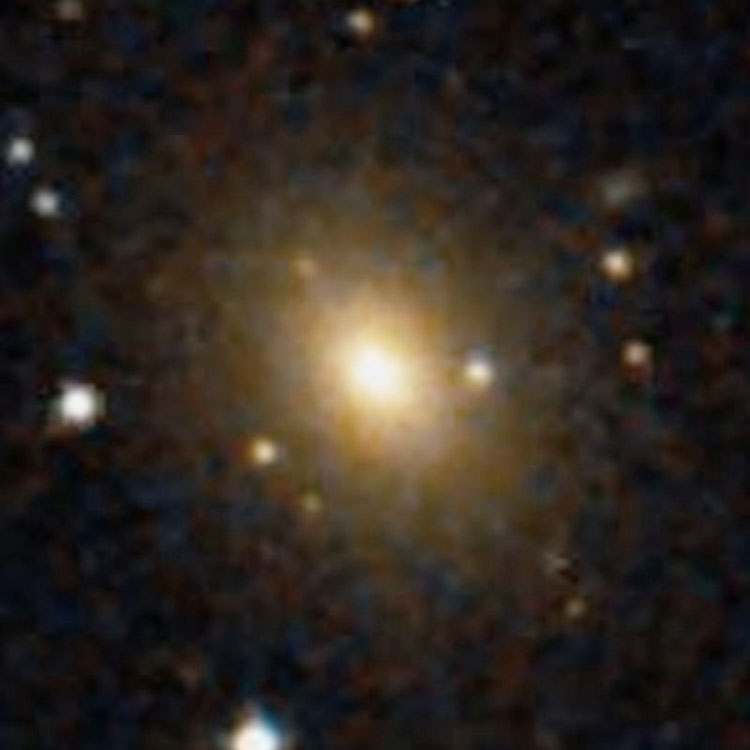
Above, a 2.4 arcmin wide closeup of NGC 2456
Below, a 12 arcmin wide region centered on the galaxy, also showing NGC 2457

NGC 2457 (= PGC 22161)
Discovered (Mar 10, 1874) by Ralph Copeland
A magnitude 15.4 spiral galaxy (type S?) in Lynx (RA 07 54 45.7, Dec +55 32 48)
Historical Identification: Per Dreyer, NGC 2457 (Copeland, using Lord Rosse's Leviathan, 1860 RA 07 43 37, NPD 34 06.2) is "faint, pretty large, round, h467 to the southwest", (JH)467 being NGC 2456, which does lie to the southwest; so the only question is which of two faint nebulae (PGC 22161 and 22171) is the one observed by Copeland. The position precesses to RA 07 54 51.1, Dec +55 32 21, which lies south of and between the two galaxies. Corwin, Steinicke, LEDA and NED list the western galaxy (PGC 22161) as NGC 2457, but Gottlieb and Wikisky list the eastern (PGC 22171). Copeland also observed the faint galaxy 3 arcmin north of NGC 2457, which is PGC 22172; and it is unfortunate that he didn't mention both of the two closer galaxies, so that the identity of NGC 2457 could be more certain. However, given the more general acceptance of PGC 22161 as the correct NGC 2457 and its slightly greater luminosity, that is what I am adopting here.
Physical Information: Apparent size 0.5 by 0.25 arcmin.

Above, a 2.4 arcmin wide closeup of PGC 22161 and 22171, centered on Dreyer's position
Below, a 12 arcmin wide region centered on PGC 22161; NGC 2456 is also shown

PGC 22171
Not an NGC object but listed here since it is sometime (mis?)identified as NGC 2457
A magnitude 15(?) spiral galaxy (type Sbc) in Lynx (RA 07 54 54.5, Dec +55 32 47)
Historical (Mis)Identification: See NGC 2457 for a discussion of that.
Physical Information:
Apparent size 0.5 by 0.2 arcmin. See NGC 2457 for images.
PGC 2506484
Not an NGC object but listed here as an apparent companion (per Corwin) of NGC 2457
A magnitude 16.5(?) spiral galaxy (type S?) in Lynx (RA 07 54 59.6, Dec +55 33 42)
Physical Information:
A discussion of NGC 2458, 2461, 2462, 2463, 2464, 2465, 2469, 2471, 2472 and 2473

Above, a nearly half degree wide region showing the six galaxies discussed immediately below
Eight of the NGC entries in Lynx have a confused history, discussed here to avoid unnecessary duplication. As noted at their entries, NGC 2463 was discovered by John Herschel, and NGC 2469 by William Herschel, then reobserved by John. Their positions were reasonably accurate, and there is no doubt of their identification. But in 1851 Bindon Stoney, working for the 3rd Lord Rosse, recorded a "great many knots, reckoned 10 nearly in a line pf", meaning running east and west. As shown in the image above there are six galaxies running in a nearly east-west line in the area in question, two of which are the Herschels' previous discoveries. Unfortunately, no positions were measured by Stoney, and in compiling his General Catalog Herschel included the supposed "novae", but with approximate positions presumably based on a general description of the region by Stoney (I seem to recall reading a discussion of a sketch of the region, but have not found the reference involved). Following Herschel's lead, Dreyer included the eight objects in his NGC, with the designations NGC 2458, 2461, 2462, 2464, 2465, 2471, 2472 and 2473.
Guillaume Bigourdan observed the region in 1886, recording moderately accurate positions for eight of the ten objects (all but NGC 2472 and 2473); Dreyer notes this by crediting the 3rd Lord Rosse and Bigourdan in his entries for the eight objects. Only four of Bigourdan's observations were of galaxies, the other four being groups of one, two or three stars (at least as best estimated by recent review of his positions and the area in question). So two of the six galaxies shown in the illustration were not observed by him, nor does it seem likely that they were observed by anyone else. Since there are two galaxies in the east-west line that have no corresponding NGC entries, and two entries (NGC 2472 and 2473) that do not correspond to any known object, modern usage (or perhaps more accurately mis-usage) has assigned the two unlisted galaxies to the two unused entries, further complicating the situation.
As a result, two of the ten NGC entries correspond to the Herschels' observations, two to Bigourdan's observations of actual nebulae, four to Bigourdan's observations of minor stellar groupings, and two to a modern assignment of the NGC numbers to the two galaxies not otherwise accounted for. With such a history it is hardly surprising that several of these NGC entries are assigned to different objects by different references. |
NGC 2458 (= PGC 22220)
Discovered (Feb 20, 1851) by Bindon Stoney
Also observed (Mar 9, 1886) by Guillaume Bigourdan
A magnitude 14.5 lenticular galaxy (type E/S0?) in Lynx (RA 07 55 51.4, Dec +56 42 38)
Historical Identification: Per Dreyer, NGC 2458 (= GC 1581, 3rd Lord Rosse, Bigourdan, 1860 RA 07 44 04, NPD 32 56.0) is "very faint, 12th magnitude star close". This is one of eight NGC objects for which the history of observation is complex, and identifications are not as certain as might be desired. For NGC 2458, Bigourdan's position precesses to RA 07 55 28.8, Dec +56 42 27, about 22.8sW and 12"S of the galaxy believed to NGC 2458. The error is larger than might be hoped, but the putative NGC 2458 is the nearest reasonably bright object, so the identification is considered reasonably certain.
Discovery Notes: Although Dreyer credits the report of the discovery to William Parsons, 3rd Earl of Rosse, he notes that many of Rosse's nebular discoveries were actually made by one of his assistants, in this case Bindon Stoney.
Physical Information: Apparent size 0.4 by 0.3 arcmin.
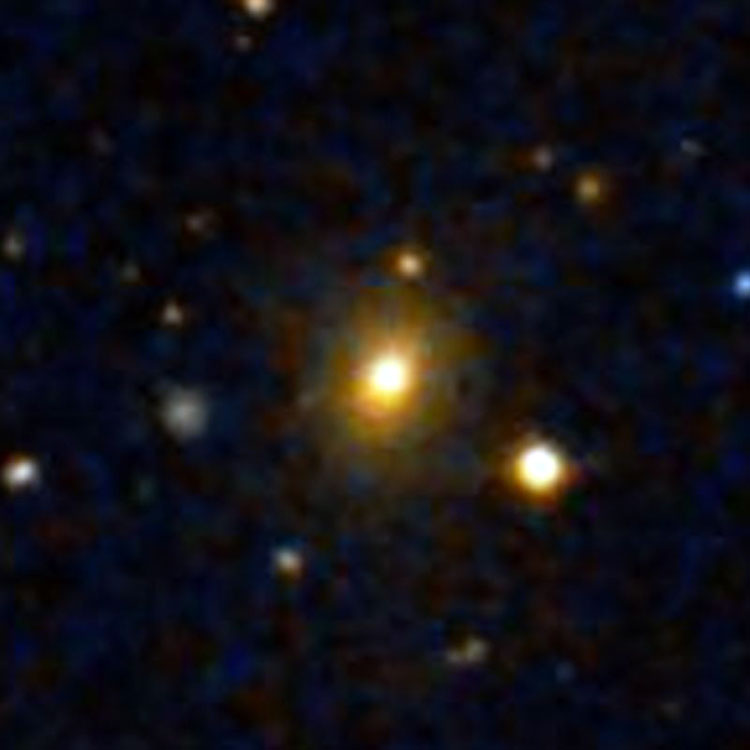
Above, a 2.4 arcmin wide closeup of NGC 2458
Below, a 12 arcmin wide region centered on the galaxy; also shown are NGC 2461, 2462 and 2473
(Dreyer's position for NGC 2458 is shown by a small box)

NGC 2459
Discovered (Dec 26, 1785) by William Herschel
Also observed (Jan 18, 1828) by John Herschel
Also observed (date?) by Rudolf Spitaler
A magnitude 12(?) group of stars in Canis Minor (RA 07 52 03.5, Dec +09 33 23)
Historical Identification: Per Dreyer, NGC 2459 (= GC 1578 = JH 468 = WH III 479, 1860 RA 07 44 24, NPD 80 05.5) is "very faint, small, partially resolved group (some stars seen) plus nebulosity". A note at the end of the NGC adds (per John Herschel) that several efforts to see any nebulosity were unsuccessful, and the first IC adds "No nebulosity, only a couple of faint stars seen by Spitaler)", so the object is just a group of faint stars. The position precesses to RA 07 52 02.8, Dec +09 33 13, about 0.2 arcmin southwest of the center of an asterism of five 13th and 14th magnitude stars, close enough that there is no real doubt about the identification with that group. The main question is whether any other stars should be included in the NGC object. Most of the faint scattering of stars surrounding the five central stars are not visible with telescopes comparable to Herschel's, and most observers agree that NGC 2459 consists of only the approximately 1.5 arcmin wide asterism.
Physical Information:

Above, a 2.4 arcmin wide closeup of NGC 2459
Below, a 12 arcmin wide region centered on the asterism

NGC 2460 (= PGC 22270)
Discovered (Aug 11, 1882) by Wilhelm Tempel
A magnitude 11.8 spiral galaxy (type Sab?) in Camelopardalis (RA 07 56 52.3, Dec +60 20 58)
Historical Identification: Per Dreyer, NGC 2460 (Tempel list VI (#3), 1860 RA 07 44 56, NPD 29 15.7) is "faint, small, round, small star in centre".
Physical Information: Several arms extend for long distances from the central galaxy, perhaps as a result of an interaction with PGC 213434; but since the distance of that galaxy is unknown, the apparent interaction may be illusory. Apparent size 2.5 by 1.9 arcmin.
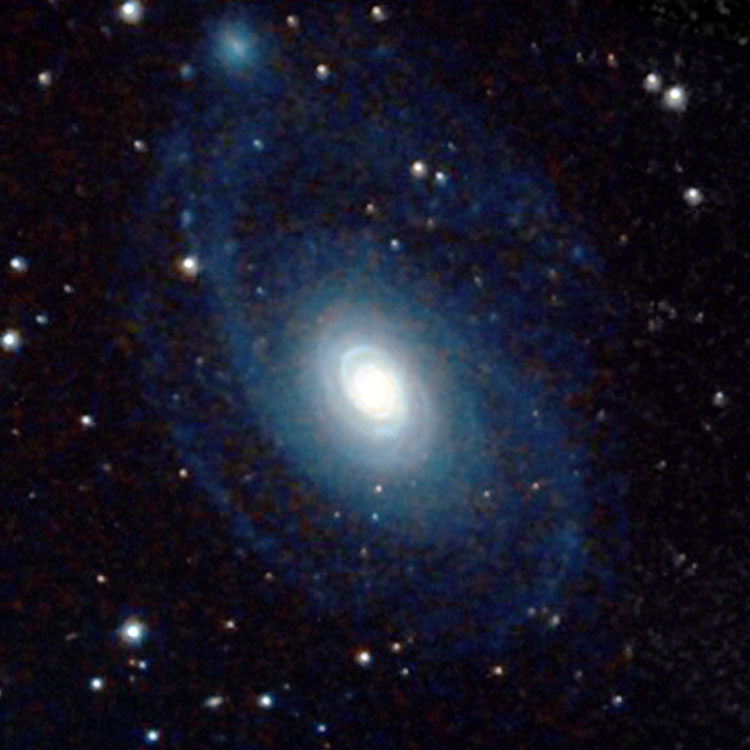
Above, a 6 arcmin wide "closeup" of NGC 2460 and at top, PGC 213434
Below, a 12 arcmin wide image centered on the galaxy; also shown is IC 2209
Both images are an overlay (with 60% opacity) of a sharper NOAO image on a "deeper" Wikisky image
(Image Credits for overlay: Charlene and Robert Key/Adam Block/AURA/NSF/NOAO)
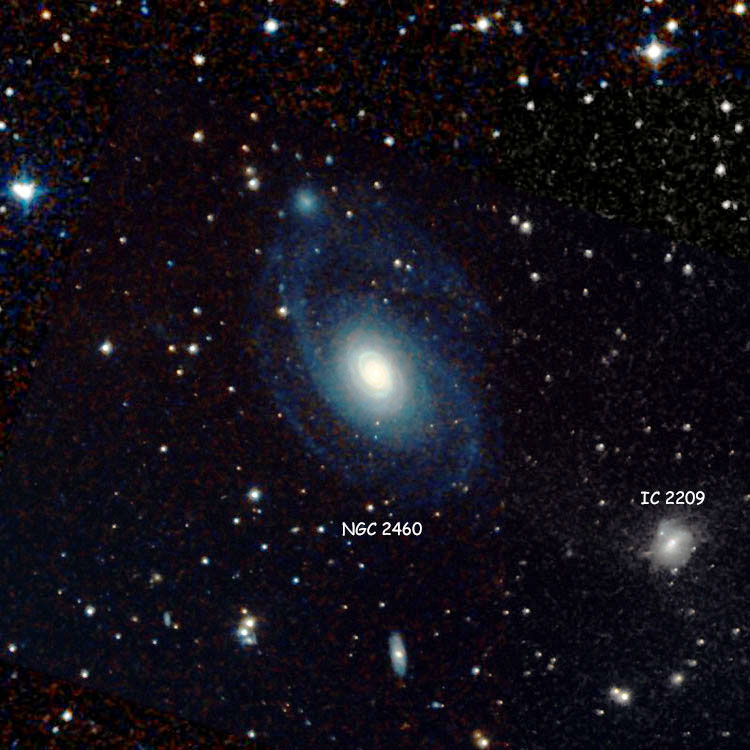
NGC 2461
Recorded (Feb 20, 1851) by Bindon Stoney
Also observed (Mar 9, 1886) by Guillaume Bigourdan
A magnitude 15.8 star in Lynx (RA 07 56 26.4, Dec +56 40 22)
Historical Identification: Per Dreyer, NGC 2461 (= 1582, 3rd Lord Rosse, Bigourdan, 1860 RA 07 45 23, NPD 32 58.2) is a "13th magnitude star, slightly nebulous". This is one of eight NGC objects for which the history of observation is complex, and identifications are not as certain as might be desired. For NGC 2461, Bigourdan's position precesses to RA 07 56 46.7, Dec +56 40 00. There is nothing at that location, so the identification of the star listed above as NGC 2461 is based on the difference between Bigourdan's measurements for NGC 2461 and 2462. Assuming that although the actual positions are wrong the relative positions are more nearly correct, NGC 2461 should be about 6sW and 11"S of NGC 2462, which see for an image of the region. That corresponds to a position just north of the star listed above, so its identification as NGC 2461 is considered more or less reasonable. (Note: Since Dreyer states that the object is a 13th-magnitude star it is tempting to assume that the 13th-magnitude star directly north of Bigourdan's position for NGC 2461 is the actual NGC 2461. But if it were, Bigourdan would have measured its position as east of NGC 2462 instead of southwest, and Herschel and Dreyer should have given it a later listing, instead of an earlier one; so it is believed that the relative positions are a better indicator of what was observed than the magnitude estimate.)
Discovery Notes: Although Dreyer credits the report of the discovery to William Parsons, 3rd Earl of Rosse, he notes that many of Rosse's nebular discoveries were actually made by one of his assistants, in this case Bindon Stoney.)
NGC 2462 (= PGC 22259)
Discovered (Feb 20, 1851) by Bindon Stoney
Also observed (Mar 9, 1886) by Guillaume Bigourdan
A magnitude 13.2 spiral galaxy (type S?) in Lynx (RA 07 56 32.0, Dec +56 41 14)
Historical Identification: Per Dreyer, NGC 2462 (= GC 1583, 3rd Lord Rosse, Bigourdan, 1860 RA 07 45 29, NPD 32 58.0) is "very faint, very small, very little brighter middle". This is one of eight NGC objects for which the history of observation is complex, and identifications are not as certain as might be desired. For NGC 2462, Bigourdan's position precesses to RA 07 56 52.7, Dec +56 40 11, about 21.8sE, 1'1" S of the "correct" position, but the only other nearby nebula is NGC 2463, which Bigourdan also observed and whose existence had already been established by the Herschels, so PGC 22259 is the only suitable candidate for NGC 2462, and the identification is considered reasonably certain.
Discovery Notes: Although Dreyer credits the report of the discovery to William Parsons, 3rd Earl of Rosse, he notes that many of Rosse's nebular discoveries were actually made by one of his assistants, in this case Bindon Stoney.
Physical Information: The apparent size is 0.4 by 0.3 arcmin.
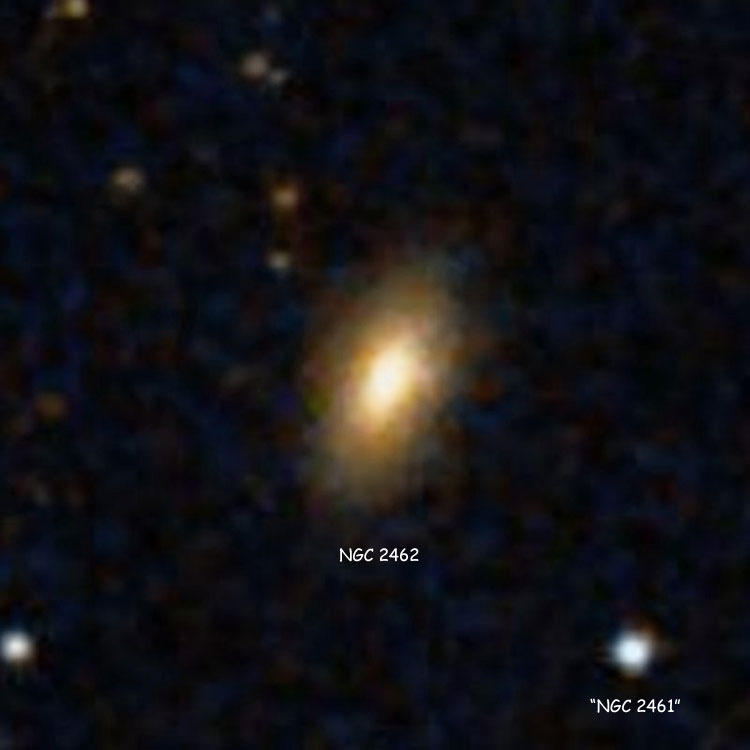
Above, a 2.4 arcmin wide region showing NGC 2462 and the star listed as NGC 2461

Below, a 12 arcmin wide region showing the star listed as NGC 2461, and NGC 2458, 2462 and 2463
Dreyer's positions for NGC 2461 and 2462 are shown by the boxes labeled D2461 and D2462
NGC 2463 (= PGC 22291)
Discovered (Feb 10, 1831) by John Herschel
A magnitude 14.2 elliptical galaxy (type E0) in Lynx (RA 07 57 12.5, Dec +56 40 36)
Historical Identification: Per Dreyer, NGC 2463 (= GC 1579 = JH 469, 1860 RA 07 45 48, NPD 32 57.7) is "extremely faint, round". The position precesses to RA 07 57 21.4, Dec +56 40 24, about 2 arcmin east of the modern position. The error is a little larger than might be desired, but there is nothing else close enough to the galaxy in question that fits the description, and there is little doubt of its identification.
Physical Information: Apparent size 0.6 by 0.6 arcmin.

Above, a 2.4 arcmin wide closeup of NGC 2463
NGC 2464
Recorded (Feb 20, 1851) by Bindon Stoney
Also observed (Mar 9, 1886) by Guillaume Bigourdan
Three 15th-magnitude stars in Lynx (RA 07 57 32.7, Dec +56 41 22)
Historical Identification: Per Dreyer, NGC 2464 (= 3rd Lord Rosse, Bigourdan, 1860 RA 07 45 58, NPD 32 58.0) is a "pretty small cluster, stars extremely faint, nebulous". This is one of eight NGC objects for which the history of observation is complex, and identifications are not as certain as might be desired. The 1860 position precesses to RA 07 57 21.4, Dec +56 40 06, which is just south of where Dreyer placed NGC 2463. The fact that he gave it a higher NGC number indicates that the "cluster" was presumed to be near and/or to the east of that galaxy, and although there is no cluster in the region there is a group of three faint stars between NGC 2463 and 2469, and that is generally presumed to be the correct identification. Whether that is correct is another matter, but since there is nothing else in the area that resembles Dreyer's description, the three stars might as well have the dubious honor of being called NGC 2464 as anything else.
Discovery Notes: Although Dreyer credits the report of the discovery to William Parsons, 3rd Earl of Rosse, he notes that many of Rosse's nebular discoveries were actually made by one of his assistants, in this case Bindon Stoney.
NGC 2465
Recorded (Feb 20, 1851) by Bindon Stoney
Also observed (Mar 9, 1886 by Guillaume Bigourdan
A lost or nonexistent object in Lynx, or perhaps
A magnitude 15.0 star at RA 07 57 26.1, Dec +56 49 18
Historical Identification: Per Dreyer, NGC 2465 (= GC 1585, 3rd Lord Rosse, Bigourdan, 1860 RA 07 46 19, NPD 32 52.7) is a "star, nebulous ?". This is one of eight NGC objects for which the history of observation is complex, and identifications are not as certain as might be desired. The position precesses to RA 07 57 43.0, Dec +56 45 20, about 18sE and 4'S of the listed position, and as of this writing the justification for choosing that star over any other of the dozens of stars in the area as "NGC 2465" escapes me. As noted in the historical summary, I believe there is some sort of sketch showing the supposed relative positions of the objects in the area, so perhaps when I can find the reference involved, things will seem more certain. However, despite some agreement among the authorities in the field, I would be surprised if there is any convincing argument for the choice of this star as the actual NGC 2465.
Discovery Notes: Although Dreyer credits the report of the discovery to William Parsons, 3rd Earl of Rosse, he notes that many of Rosse's nebular discoveries were actually made by one of his assistants, in this case Bindon Stoney.
NGC 2466 (= PGC 21714)
Discovered (Feb 20, 1835) by John Herschel
A magnitude 13.0 spiral galaxy (type Sc) in Volans (RA 07 45 16.0, Dec -71 24 38)
Historical Identification: Per Dreyer, NGC 2466 (= GC 1580 = JH 3104, 1860 RA 07 46 21, NPD 161 03.6) is "very faint, small, round, a little brighter middle".
Physical Information:
Apparent size 1.6 by 1.4 arcmin
NGC 2467 (= OCL 668 + LBN 1065)
Discovered (Dec 9, 1784) by William Herschel
Also observed (Jan 7, 1831) by John Herschel
A magnitude 7.1 emission nebula and open cluster in Puppis (RA 07 52 20.3, Dec -26 25 47)
Historical Identification: Per Dreyer, NGC 2467 (= GC 1589 = JH 472 = Wh IV 22, 1860 RA 07 46 40, NPD 116 02.0) is "pretty bright, very large, round, extremely mottled but not resolved, middle equivalent to 8th magnitude star".
Note: The position above is probably for the emission nebula; Corwin lists the position of the cluster as RA 07 52 45.0, Dec -26 22 00
Physical Information:
NGC 2468 (= PGC 22325)
Discovered (Jan 1, 1865) by Heinrich d'Arrest
A magnitude 13.9 lenticular galaxy (type S0(s)a?) in Lynx (RA 07 58 02.5, Dec +56 21 34)
Historical Identification: Per Dreyer, NGC 2468 (= GC 5397, d'Arrest, 1860 RA 07 46 41, NPD 33 16.5) is "faint, round, brighter middle".
Physical Information:
Apparent size 1.3 by 0.6 arcmin
PGC 200240
Not an NGC object but listed here as an apparent companion (per Corwin) to NGC 2468
A magnitude 17(?) galaxy (type S0?) in Lynx (RA 07 58 01.1, Dec +56 21 07)
Physical Information:
NGC 2469 (= PGC 22327)
Discovered (Mar 18, 1790) by William Herschel
Also observed (Feb 9, 1831) by John Herschel
A magnitude 12.7 spiral galaxy (type Sb pec) in Lynx (RA 07 58 03.4, Dec +56 40 50)
Historical Identification: Per Dreyer, NGC 2469 (= GC 1590 = JH 470 = WH III 836, 1860 RA 07 46 42, NPD 32 57.1) is "faint, very small, round, 9th magnitude star to southeast". The position precesses to RA 07 58 05.1, Dec +56 40 52, which is within the outline of the galaxy, and despite the error in the position of the nearby star (which is to the northeast), the identification seems certain.
Physical Information: Apparent size 1.0 by 0.7 arcmin.
NGC 2470 (= PGC 22137)
Discovered (Oct 24, 1886) by Lewis Swift
A magnitude 12.7 spiral galaxy (type Sab) in Canis Minor (RA 07 54 20.7, Dec +04 27 35)
Historical Identification: Per Dreyer, NGC 2470 (Swift list V (#68), 1860 RA 07 46 51, NPD 85 10.9) is "extremely faint, small, a little extended, between 2 stars".
Physical Information:
Apparent size 2.0 by 0.6 arcmin
NGC 2471
Recorded (Feb 20, 1851) by Bindon Stoney
Also observed (Mar 9, 1886) by Guillaume Bigourdan
A lost or nonexistent object in Lynx, or perhaps
A pair of stars in Lynx (RA 07 58 32.9, Dec +56 46 32)
Historical Identification: Per Dreyer, NGC 2471 (= GC 1586, 3rd Lord Rosse, Bigourdan, 1860 RA 07 46 52, NPD 32 52.5) is a "13th magnitude star, slightly nebulous".
This is one of eight NGC objects for which the history of observation is complex, and identifications are not as certain as might be desired. The position precesses to RA 07 58 15.7, Dec +56 45 26, and although there is a 14th-magnitude star not far from the position, the "chosen object" is the pair of stars well to the east, as listed above. As noted for several other objects in the region, the choice of any particular object for this NGC listing seems arbitrary and not at all convincing; but not being an expert in the history of this investigation, any further discussion will have to wait until I can unravel the rest of the tangled tale, and at least until the next iteration of this page.
Discovery Notes: Although Dreyer credits the report of the discovery to William Parsons, 3rd Earl of Rosse, he notes that many of Rosse's nebular discoveries were actually made by one of his assistants, in this case Bindon Stoney.
PGC 22364 (= "NGC 2472")
Recorded (Feb 20, 1851) by Bindon Stoney
NGC 2472 is a lost or nonexistent object, now associated with PGC 22364 for reasons discussed below
PGC 22364 = A magnitude 15.3 spiral galaxy (type S?) in Lynx (RA 07 58 41.8, Dec +56 42 04)
Historical Identification: Per Dreyer, NGC 2472 (= GC 1587, 3rd Lord Rosse, 1860 RA 07 47, NPD 32 57 ) is one of "2 of 10 nebulae in line with h469, 470)". (JH)469 and 470 are NGC 2463 and 2469. A full discussion of the historical difficulties covered above reveals that NGC 2472 and 2473 were never observed with sufficient accuracy to identify them with any specific object. A proper description should therefore be "lost or nonexistent". However, there are six galaxies stretching in an east-west line in the region where the ten objects listed by Dreyer are supposed to have been, and only four of them correspond to specific NGC listings. As a result, there has been a modern "recycling" of the unidentifiable NGC numbers to account for the two unlisted galaxies. This is certainly historically incorrect; but since this usage appears to have gained general acceptance, it seems appropriate to discuss the galaxies associated with those listings, if only to show the modern interpretation of the designation.
Discovery Notes: Although Dreyer credits the report of the discovery to William Parsons, 3rd Earl of Rosse, he notes that many of Rosse's nebular discoveries were actually made by one of his assistants, in this case Bindon Stoney.
Physical Information:
The apparent size of PGC 22364 is 0.5 by 0.5 arcmin.
PGC 22191 (= "NGC 2473")
Recorded (Feb 20, 1851) by Bindon Stoney
NGC 2473 is a lost or nonexistent object, now associated with PGC 22191 for reasons discussed below
PGC 22191 = A magnitude 15.1 spiral galaxy (type S) in Lynx (RA 07 55 34.8, Dec +56 44 09)
Historical Identification: Per Dreyer, NGC 2472 and 2473 (= GC 1588, 3rd Lord Rosse, 1860 RA 07 47, NPD approx 32 57 ) are "2 of 10 nebulae in line with h469, 470)". (JH)469 and 470 are NGC 2463 and 2469.
A full discussion of the historical difficulties covered above reveals that NGC 2472 and 2473 were never observed with sufficient accuracy to identify them with any specific object. A proper description should therefore be "lost or nonexistent". However, there are six galaxies stretching in an east-west line in the region where the ten objects listed by Dreyer are supposed to have been, and only four of them correspond to specific NGC listings. As a result, there has been a modern "recycling" of the unidentifiable NGC numbers to account for the two unlisted galaxies. This is certainly historically incorrect; but since this usage appears to have gained general acceptance, it seems appropriate to discuss the galaxies associated with those listings, if only to show the modern interpretation of the designation.
Discovery Notes: Although Dreyer credits the report of the discovery to William Parsons, 3rd Earl of Rosse, he notes that many of Rosse's nebular discoveries were actually made by one of his assistants, in this case Bindon Stoney.
Physical Information:
The apparent size of PGC 22191 is 0.5 by 0.3 arcmin.
NGC 2474 (= PGC 22322)
Discovered (Mar 17, 1790) by William Herschel
Also observed (Feb 16, 1831) by John Herschel
A magnitude 13.1 elliptical galaxy (type E0) in Lynx (RA 07 57 59.0, Dec +52 51 26)
Historical Identification: Per Dreyer, NGC 2474 (= GC 1591 = JH 471 = WH III 830, 1860 RA 07 47 11, NPD 36 46.2) is "faint, pretty small, extended?, brighter middle and very small (faint) star?, large (bright) star to northeast".
Physical Information:
Apparent size 0.8 by 0.8 arcmin. A companion of NGC 2475.
NGC 2475 (= PGC 22321)
Discovered (Jan 9, 1856) by R. J. Mitchell
A magnitude 13.2 elliptical galaxy (type E0) in Lynx (RA 07 58 00.4, Dec +52 51 42)
Historical Identification: Per Dreyer, NGC 1592 (3rd Lord Rosse, 1860 RA 07 47 12, NPD 36 46.0) "Makes double nebula with h 471", (JH) 471 being NGC 2474.
Discovery Notes: Although Dreyer credits the report of the discovery to William Parsons, 3rd Earl of Rosse, he notes that many of Rosse's nebular discoveries were actually made by one of his assistants, in this case R. J. Mitchell.
Physical Information:
Apparent size 0.6 by 0.6 arcmin. A companion of NGC 2474.
NGC 2476 (= PGC 22260)
Discovered (Feb 23, 1878) by Édouard Stephan
A magnitude 12.6 elliptical galaxy (type E4) in Lynx (RA 07 56 45.2, Dec +39 55 40)
Historical Identification: Per Dreyer, NGC 2476 (Stephan list IX (#13), 1860 RA 07 47 16, NPD 49 42.4) is "very small (faint) star in extremely faint, small nebula".
Physical Information:
Apparent size 1.4 by 0.8 arcmin
NGC 2477
(= C71 = OCL 720 = "PGC 3518239" = ESO 311-SC017)
Discovered (1751) by Nicolas Lacaille
Also observed (May 8, 1826) by James Dunlop
A magnitude 5.8 open cluster (type I3r) in Puppis (RA 07 52 16.0, Dec -38 32 36)
Historical Identification: Per Dreyer, NGC 2477 (= GC 1593 = JH 3103, Lacaille I.3, Dunlop #535, 1860 RA 07 47 19, NPD 128 11.1) is "a remarkable object, a cluster, bright, rich, large, a little compressed, 12th magnitude stars".
Physical Information:
Apparent size 20 arcmin

Above, a 40 arcmin wide ESO image centered on NGC 2477 (Image Credit ESO/J.P rez)
NGC 2478 ( = NGC 2422 = M47 = OCL 596)
Discovered (before 1654) by Giovanni Hodierna
Discovered (Feb 19, 1771) by Charles Messier (and recorded as M47)
Discovered (early 1783) by Caroline Herschel
Discovered (Feb 4, 1785) by William Herschel (and later listed as NGC 2422)
(Steinicke lists WH's observation as Oct 12, 1782; need to check reasoning for the change in the date)
A magnitude 4.4 open cluster in Puppis (RA 07 36 21.0, Dec -14 29 36)
Historical Identification: Per Dreyer, NGC 2478 (= GC 1594, M47, 1860 RA 07 48 20, NPD 105 03.3) is "a cluster". The position precesses to RA 07 54 45.2, Dec -15 25 11. There is nothing of note at that position, and for the best part of a century M47 was thought to be lost or nonexistent. It was only in 1959 that it was realized that what Messier observed was the Herschels' NGC 2422 (which see for images and physical data), and that a substantial error in Messier's calculation of its position led to the double listing. As a result, this entry will only discuss historical information (although as part of that discussion, an image centered on Messier's incorrect position will be added at a later date).
NGC 2479 (= OCL 623)
Discovered (Mar 4, 1790) by William Herschel
A magnitude 9.6 open cluster (type III1m) in Puppis (RA 07 55 06.0, Dec -17 42 48)
Historical Identification: Per Dreyer, NGC 2479 (= GC 1595 = WH VII 58, 1860 RA 07 48 40, NPD 107 21.1) is "a cluster, pretty large, pretty rich, pretty compressed, stars small (faint)".
Physical Information:
Apparent size 11.0 arcmin
NGC 2480 (= PGC 22289)
Discovered (Feb 1, 1856) by R. J. Mitchell
A magnitude 13.8 spiral galaxy (type SBcd) in Gemini (RA 07 57 10.4, Dec +23 46 47)
Historical Identification: Per Dreyer, NGC 2480 (= GC 1597, 3rd Lord Rosse, 1860 RA 07 48, NPD 65 51 ) is "very faint, extended northwest southeast, close northwest of h 473", (JH) 473 being NGC 2481.
Discovery Notes: Although Dreyer credits the report of the discovery to William Parsons, 3rd Earl of Rosse, he notes that many of Rosse's nebular discoveries were actually made by one of his assistants, in this case R. J. Mitchell.
Physical Information:
Apparent size 1.3 by 0.7 arcmin. A companion of NGC 2481.
NGC 2481 (= PGC 22292)
Discovered (Feb 28, 1785) by William Herschel
A magnitude 13.0 lenticular galaxy (type S0/a) in Gemini (RA 07 57 13.8, Dec +23 46 04)
Historical Identification: Per Dreyer, NGC 2481 (= GC 1596 = JH 473 = WH II 302, 1860 RA 07 48 48, NPD 65 52.1) is "faint, small, a little extended, brighter middle, extremely mottled but not resolved".
Physical Information:
Apparent size 1.4 by 0.5 arcmin. A companion of NGC 2480.
NGC 2482 (= OCL 653)
Discovered (Nov 20, 1784) by William Herschel
A magnitude 7.3 open cluster (type III1m) in Puppis (RA 07 55 14.0, Dec -24 15 42)
Historical Identification: Per Dreyer, NGC 2482 (= GC 1598 = JH 474 = JH 3106 = WH VII 10, 1860 RA 07 49 01, NPD 113 56.2) is "a cluster, large, considerably rich, very little compressed".
Physical Information:
Apparent size 10.0 arcmin
NGC 2483 (= OCL 677)
Discovered (Jan 22, 1835) by John Herschel
A magnitude 7.6 open cluster in Puppis (RA 07 55 42.0, Dec -27 52 18)
Historical Identification: Per Dreyer, NGC 2483 (= GC 1599 = JH 3105, 1860 RA 07 49 02, NPD 117 30.0) is "a cluster, large, a little compressed".
Note: The position above is Corwin's estimate of the "center" of the cluster, but he places the "core" at RA 07 55 37, Dec -27 53 12.
Physical Information:
Apparent size 9.0 arcmin
NGC 2484 (= PGC 22350)
Discovered (Jan 21, 1885) by Édouard Stephan
A magnitude 13.0 lenticular galaxy (type S0) in Lynx (RA 07 58 28.1, Dec +37 47 12)
Historical Identification: Per Dreyer, NGC 2484 (Stephan list XIII (#34), 1860 RA 07 49 10, NPD 51 50.5) is "very faint, very small, round, brighter middle, mottled but not resolved?".
Physical Information:
Apparent size 0.9 by 0.8 arcmin
NGC 2485 (= PGC 22266)
Discovered (Mar 25, 1864) by Albert Marth
A magnitude 12.2 spiral galaxy (type Sa) in Canis Minor (RA 07 56 48.7, Dec +07 28 41)
Historical Identification: Per Dreyer, NGC 2485 (= GC 5398, Marth #107, 1860 RA 07 49 17, NPD 82 09) is "a nebulous star of 12 magnitude".
Physical Information:
Apparent size 1.6 by 1.4 arcmin
PGC 213436
Not an NGC object but listed here as an apparent companion to NGC 2485
A magnitude 16(?) spiral galaxy (type SBbc? pec) in Canis Minor (RA 07 56 45.4, Dec +07 28 49)
Physical Information:
NGC 2486 (= PGC 22317)
Discovered (Nov 7, 1864) by Albert Marth
A magnitude 13.3 spiral galaxy (type Sa) in Gemini (RA 07 57 56.5, Dec +25 09 39)
Historical Identification: Per Dreyer, NGC 2486 (= GC 5399, Marth #108, 1860 RA 07 49 25, NPD 64 26) is "very faint, small, pretty suddenly brighter middle".
Physical Information:
Apparent size 1.7 by 0.9 arcmin. A companion of NGC 2487.
NGC 2487 (= PGC 22343)
Discovered (Nov 7, 1864) by Albert Marth
A magnitude 12.5 spiral galaxy (type SBb) in Gemini (RA 07 58 20.5, Dec +25 08 57)
Historical Identification: Per Dreyer, NGC 2487 (= GC 5400, Marth #109, 1860 RA 07 49 49, NPD 64 27) is "very faint, small, gradually brighter middle".
Physical Information:
Apparent size 2.7 by 2.1 arcmin. A companion of NGC 2486.
NGC 2488 (= PGC 22520)
Discovered (Mar 18, 1790) by William Herschel
Also observed (Feb 9, 1831) by John Herschel
A magnitude 12.4 lenticular galaxy (type E/S0) in Lynx (RA 08 01 45.9, Dec +56 33 12)
Historical Identification: Per Dreyer, NGC 2488 (= GC 1600 = JH 475 = WH III 837, 1860 RA 07 50 26, NPD 33 03.9) is "very faint, very small, round, gradually a little brighter middle".
Physical Information:
Apparent size 1.4 by 0.8 arcmin
NGC 2489 (= OCL 690)
Discovered (Dec 30, 1785) by William Herschel
Also observed (May 28, 1826) by James Dunlop
Also observed (Jan 6, 1831) by John Herschel
A magnitude 7.9 open cluster (type II2m) in Puppis (RA 07 56 14.0, Dec -30 03 42)
Historical Identification: Per Dreyer, NGC 2489 (= GC 1601 = JH 479 = JH 3107 = WH VII 23, Dunlop #626, 1860 RA 07 50 37, NPD 119 42.0) is "a cluster, pretty large, considerably rich, pretty compressed, stars from 11th to 13th magnitude".
Physical Information:
Apparent size 5.0 arcmin
NGC 2490 (= PGC 22382)
Discovered (Feb 14, 1857) by R. J. Mitchell
A magnitude 14.6 compact galaxy (type C) in Gemini (RA 07 59 17.9, Dec +27 04 40)
Historical Identification: Per Dreyer, NGC 2490 (= GC 1603, 3rd Lord Rosse, 1860 RA 07 50 42, NPD 62 35.8) is "very faint, small, round, 13th magnitude star 1 arcmin to east, preceding (western) of 2", the other being NGC 2492.
Discovery Notes: Although Dreyer credits the discovery to William Parsons, 3rd Earl of Rosse, he notes that many of Rosse's nebular discoveries were actually made by one of his assistants, in this case R. J. Mitchell.
Physical Information:
Apparent size 0.6 by 0.4 arcmin
NGC 2491 (= PGC 22353)
Discovered (Nov 15, 1885) by Lewis Swift
Also observed (date?) by Herbert Howe
A magnitude 14.8 spiral galaxy (type S) in Canis Minor (RA 07 58 27.4, Dec +07 59 02)
Historical Identification: Per Dreyer, NGC 2491 (Swift list III (#37), 1860 RA 07 50 49, NPD 81 37.6) is "extremely extremely faint, pretty small, irregularly round, very difficult, bright star to west". The second IC notes (per Howe) "Only a few stars 14th magnitude. The 'bright star' is 10th magnitude".
Physical Information: Apparent size 0.3 by 0.2 arcmin?
PGC 22334
Probably not an NGC object but listed as a possible candidate for NGC 2491
A magnitude 15(?) lenticular galaxy (type S0(r)?) in Canis Minor (RA 07 58 13.9, Dec +08 09 02)
Historical Identification:
Physical Information:
PGC 22355 = PGC 1340054
Probably not an NGC object but listed as a possible candidate for NGC 2491
A magnitude 15(?) lenticular galaxy (type S0?) in Canis Minor (RA 07 58 25.5, Dec +08 08 41)
Historical Identification:
Physical Information:
NGC 2492 (= PGC 22397)
Discovered (Dec 24, 1827) by John Herschel
A magnitude 12.7 lenticular galaxy (type E/S0) in Gemini (RA 07 59 29.7, Dec +27 01 35)
Historical Identification: Per Dreyer, NGC 2492 (= GC 1602 = JH 477, 1860 RA 07 50 54, NPD 62 36.0) is "very faint, small, round, brighter middle, following (eastern) of 2", the other being NGC 2490.
Physical Information:
Apparent size 1.0 by 1.0 arcmin
NGC 2493 (= PGC 22447)
Discovered (Dec 31, 1788) by William Herschel
Also observed (Mar 18, 1831) by John Herschel
A magnitude 12.0 lenticular galaxy (type SB0) in Lynx (RA 08 00 23.6, Dec +39 49 50)
Historical Identification: Per Dreyer, NGC 2493 (= GC 1604 = JH 476 = WH III 750, 1860 RA 07 50 55, NPD 49 47.8) is "considerably bright, small, round, suddenly brighter middle".
Physical Information:
Apparent size 1.9 by 1.9 arcmin
NGC 2494 (= PGC 22377 = IC 487)
Discovered (Feb 6, 1864) by Albert Marth (and later listed as NGC 2494)
Discovered (Feb 3, 1888) by Lewis Swift (and later listed as IC 487)
A magnitude 13.1 lenticular galaxy (type (R)SB0/a(rs)) in Monoceros (RA 07 59 07.1, Dec -00 38 17)
Historical Identification: Per Dreyer, NGC 2494 (= GC 5401, Marth #110, 1860 RA 07 50 58, NPD 90 15) is "faint, small, a little extended".
Physical Information:
Apparent size 0.9 by 0.7 arcmin
NGC 2495 (= PGC 22457)
Discovered (Feb 14, 1855) by R. J. Mitchell
A magnitude 15.2 spiral galaxy (type Sd) in Lynx (RA 08 00 33.2, Dec +39 50 24)
Historical Identification: Per Dreyer, NGC 2495 (= GC 1605, 3rd Lord Rosse, 1860 RA 07 51 +, NPD 49 47 ) "Follows III 750 by 2 or 3 arcmin, extremely faint, very small", (WH) III 750 being NGC 2493.
Discovery Notes: Although Dreyer credits the discovery to William Parsons, 3rd Earl of Rosse, he notes that many of Rosse's nebular discoveries were actually made by one of his assistants, in this case R. J. Mitchell. Also, it seems probable that the "+" sign in the 1860 RA is a misprint of the that similarly follows the NPD.
Physical Information:
Apparent size 0.4 by 0.2 arcmin
NGC 2496 (= PGC 22359)
Discovered (Nov 15, 1885) by Lewis Swift
Also observed (date?) by Herbert Howe
A magnitude 12.9 elliptical galaxy (type E2) in Canis Minor (RA 07 58 37.4, Dec +08 01 47)
Apparent size 1.1 by 0.9 arcmin.
Historical Identification: Per Dreyer, NGC 2496 (Swift list III (#38), 1860 RA 07 51 04, NPD 81 36.3) is "very faint, pretty small, round, a little brighter middle, star close to east". The second IC adds (per Howe) "The star (11th magnitude) is 3 seconds to the west".
Physical Information: Apparent size of about 1.1 by 0.9 arcmin?
NGC 2497 (= PGC 22547)
Discovered (Mar 18, 1790) by William Herschel
A magnitude 13.2 lenticular galaxy (type E/S0) in Lynx (RA 08 02 11.1, Dec +56 56 32)
Historical Identification: Per Dreyer, NGC 2497 (= GC 1606 = WH III 838, 1860 RA 07 51 11, NPD 32 42.3) is "extremely faint, very small".
Physical Information:
Apparent size 1.4 by 1.2 arcmin
NGC 2498 (= PGC 22403)
Discovered (Jan 19, 1885) by Édouard Stephan
A magnitude 13.4 spiral galaxy (type SBa) in Gemini (RA 07 59 38.8, Dec +24 58 56)
Historical Identification: Per Dreyer, NGC 2498 (Stephan list XIII (#35), 1860 RA 07 51 12, NPD 64 38.5) is "very faint, very small, round, brighter middle and nucleus".
Physical Information:
Apparent size 1.1 by 0.8 arcmin
NGC 2499 (= PGC 22366)
Discovered (Mar 25, 1864) by Albert Marth
A magnitude 14.0 spiral galaxy (type SB?) in Canis Minor (RA 07 58 51.7, Dec +07 29 36)
Historical Identification: Per Dreyer, NGC 2499 (= GC 5402, Marth #111, 1860 RA 07 51 23, NPD 82 08) is "extremely faint, pretty small, irregularly round".
Physical Information:
Apparent size 0.8 by 0.5 arcmin

Above, a 2.4 arcmin closeup of NGC 2499
Below, a 12 arcmin wide region centered on the galaxy

|